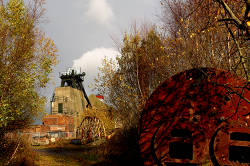Pleasley Colliery
Pleasley Pit and Country Park
Useful Information
| Location: | Northwest of Peasley. 4.8 km north of Mansfield, 14.5 km south of Chesterfield. (53.1742, -1.255) |
| Open: |
Wed, Sat, Sun 10-14. [2020] |
| Fee: | |
| Classification: |
 Coal Mine Coal Mine
|
| Light: |
 Incandescent Incandescent
|
| Dimension: | A=152 m asl. |
| Guided tours: | |
| Photography: | allowed |
| Accessibility: | wheelchair Friendly |
| Bibliography: |
P.J.M. Southworth (2004):
Pleasley Pit and its Steam Winding Engines,
Published by author. ISBN 0-9511856-3-2.
|
| Address: |
Pleasley Colliery
E-mail: |
| As far as we know this information was accurate when it was published (see years in brackets), but may have changed since then. Please check rates and details directly with the companies in question if you need more recent info. |
|
History
| 1872 | lease for the extraction of coal from the Top Hard seam was granted to the Stanton Iron Company by William Edward Nightingale. |
| 1872 | Pit sunk. |
| 1879 | mine started production. |
| 1881 | electric lighting of the pit bottom installed. |
| 1888 | main winding shaft reached its maximum capacity. |
| 1904 | steam winder installed by Lilleshall Co. Ltd. |
| 1922 | steam winder installed by Markham & Co. Ltd. |
| 1983 | coal-winding at Pleasley ended. |
| 1986 | preservation listing. |
| 1995 | preservation group Friends of Pleasley Pit formed and begin of restoration. |
| 1996 | scheduled as an Ancient Monument. |
Geology
Description

Pleasley Colliery, locally called Pleasley Pit, is named after nearby town Peasley. The ground belonged to the manor of Pleasley which was bought 1823 by William Edward Nightingale for £38,000. He was the father of the famous Victorian nursing pioneer Florence Nightingale. In 1872, he granted a lease for the extraction of coal from the Top Hard seam, together with the construction and operation of a colliery, to the Stanton Iron Company. Florence Nightingale is reputed to have “turned the first sod” at the commencement of sinking the pit. William Nightingale died in a tragic accident in 1874 and the manor passed to his other daughter, Parthenon Nightingale, the wife of Sir Harry Verney.
After the lease, work soon started on leveling the site and preparing the surface infrastructure and access roads. 1873 two 14.5 ft. diameter shafts were sunk and the engine-houses were constructed. In 1874 two pairs of steam winding engines built by the Worsley Mesnes Iron Co. were installed. The first drawback was high volumes of water in the shafts, then a serious depression in the iron and coal trade, and the works were stopped for several months. Four 18in. diameter pumps were installed in the No. 1 shaft and the No.2 shaft was not continued. The pumping was successful but dried up all wells in a radius of three miles. The shaft was lined for about 115 m with cast-iron tubbing, and most of the pumping equipment was removed. When the seam was reached in 1877, the second shaft was constructed in the same way. In 1879 the sinking was completed and the mine started to produce coal.
In 1881 electric lighting of the pit bottom and the coal face was installed. The electrical engineer R.E.B. Crompton demonstrated the light to the Royal Commission on Accidents in Mines. Production increased continually until the main winding shaft reached its maximum capacity in 1888. The other shaft was fitted out for coal winding and output continued to climb. The first 60HP electrically driven underground rope-haulage system of the world was installed to replace the mine ponies. The production increased continually and numerous changes and upgrades were made in the next years. In 1938, 1,261 miners were employed underground and a further 283 on the surface.
After World War II, the mine was still producing coal, but manpower was in short supply, and only 895 miners worked underground. After nationalization, a major development program was started with a fully automatic pneumatic systems. But finally the mine had reached a considerable size and connected with Shirebrook colliery. The surface infrastructure at Pleasley made problems because of its age, and all output was switched to Shirebrook colliery. The shafts were used to supply air to Shirebrook. The local authorities gave the remains a preservation listing before they were demolished. In 1995 the restoration by the newly formed preservation group Friends of Pleasley Pit started. It was scheduled as an Ancient Monument and the headgears, the engine-house roof and the chimney have been renovated.
The visit to Pleasly Pit is restricted to the surface, there is no underground tour as the colliery is closed. The Friends of Pleasley Pit erected a new visitor center and renovated the North Winding Engine and the South Shaft Pit Top. The South Winding Engine is in the process of renovation.
- See also
 Search DuckDuckGo for "Pleasley Colliery"
Search DuckDuckGo for "Pleasley Colliery" Google Earth Placemark
Google Earth Placemark Pleasley Colliery - Wikipedia (visited: 17-JUL-2020)
Pleasley Colliery - Wikipedia (visited: 17-JUL-2020) Pleasley Pit and Country Park, official website (visited: 17-JUL-2020)
Pleasley Pit and Country Park, official website (visited: 17-JUL-2020) Pleasley Pit Country Park and Local Nature Reserve (LNR) (visited: 17-JUL-2020)
Pleasley Pit Country Park and Local Nature Reserve (LNR) (visited: 17-JUL-2020) Winner of a Regional Master Builder of the Year Award in 2010 (visited: 23-JUL-2020)
Winner of a Regional Master Builder of the Year Award in 2010 (visited: 23-JUL-2020) English Heritage praises Pleasley Colliery restoration (visited: 23-JUL-2020)
English Heritage praises Pleasley Colliery restoration (visited: 23-JUL-2020) Pleasley Colliery (visited: 23-JUL-2020)
Pleasley Colliery (visited: 23-JUL-2020)
 Index
Index Topics
Topics Hierarchical
Hierarchical Countries
Countries Maps
Maps